Innovative Bioceramic Based on Hydroxyapatite with Titanium Nanoparticles as Reinforcement for Possible Medical Applications
Abstract
:1. Introduction
2. Materials and Methods
3. Results
3.1. Particle Size
3.2. Structure
3.3. Microstructure
3.4. Morphology
3.5. Energy-Dispersive Spectroscopy
3.6. Mechanical Properties
3.6.1. Open Porosity
3.6.2. Hardness
3.6.3. Elastic Modulus
3.6.4. Compression Strength
3.6.5. Fracture Toughness
3.7. Electrochemical Characterization
3.7.1. Potentiodynamic Polarization Curves (TAFEL)
3.7.2. Electrochemical Impedance Measurements (EISs)
4. Conclusions
- ○
- Through the proposed methodology, hydroxyapatite biomaterials reinforced with titanium nanoparticles were successfully fabricated.
- ○
- The resulting biomaterial is constituted by two hexagonal compacted crystalline phases, one corresponding to the hydroxyapatite ceramic matrix and a second phase that corresponds to the reinforced titanium metal.
- ○
- From the results obtained in the mechanical properties’ measurements, it is concluded that the biomaterial reinforced with 1 wt. % Ti presents the best mechanical behavior.
- ○
- Electrochemical tests (OCP, anodic polarization, and EIS) show significant results in which the bioceramic is stabilized by the mechanism of chemical and physical adsorption of ions during its exposure for prolonged times (504 h, 21 d) in the physiological medium of 0.9% NaCl. Thus, developing bioactivity through a film formed by hydroxide compounds due to a surface sealing of the nanometric porous structure of hydroxyapatite, this phenomenon occurs at potentials close to −782.71 mV with an ionic charge transfer of about 0.43 × 10−9 A/cm2. This biofilm is a capacitor that stores a low ionic charge of 0.18 nF/cm2 and allows a charge transfer of 1.526 × 106 W cm2 to develop its bioactivity.
- ○
- Finally, in practical applications such as insertion in a physiological medium, the biofilm plays a crucial role. It is firmly anchored to the bone and facilitates cellular osseointegration by providing biocompatibility. The Ti particles, on the other hand, contribute to mechanical strength and serve as anchoring sites to the bone.
Author Contributions
Funding
Data Availability Statement
Acknowledgments
Conflicts of Interest
References
- Ríos-Puerta, K.; Gutiérrez-Flores, O.D. Aleaciones metálicas para aplicaciones ortopédicas: Una revisión sobre su respuesta al estrés fisiológico y a los procesos de corrosión. Rev. Politécnica 2022, 18, 24–39. [Google Scholar] [CrossRef]
- Black, J.; Hastings, G. Handbook of Biomaterial Properties, 1st ed.; Springer Science & Business Media: London, UK, 1998. [Google Scholar]
- Chen, Q.; Thouas, G.A. Metallic implant biomaterials. Mat. Sci. Eng. R Rep. 2015, 87, 1–57. [Google Scholar] [CrossRef]
- Manam, N.S.; Harun, W.S.W.; Shri, D.N.A.; Ghani, S.A.C.; Kurniawan, T.; Ismail, M.H.; Ibrahim, M.H.I. Study of corrosion in biocompatible metals for implants: A review. J. Alloys Compd. 2017, 701, 698–715. [Google Scholar] [CrossRef]
- García-Garduño, M.V.; Reyes-Gasga, J. La hidroxiapatita, su importancia en los tejidos mineralizados y su aplicación bio-médica. TIP Rev. Espec. En Cienc. Químico-Biológicas 2006, 9, 90–95. [Google Scholar]
- Smith Deanne, K. Calcium phosphate apatites in nature. In Hydroxyapatite and Related Materials; Browns, P.W., Constantz, B., Eds.; CRC Press: London, UK, 2000; pp. 46–52. [Google Scholar]
- Zapanta Legeros, R. Biological and synthetic apatites. In Hydroxyapatite and Related Materials; Browns, P.W., Constantz, B., Eds.; CRC Press: London, UK, 2000; pp. 1–28. [Google Scholar]
- Fernández, J.; Gilemany, J.M.; Gaona, M. La proyección térmica en la obtención de recubrimientos biocompatibles ventajas de la proyección térmica por alta velocidad (HVOF) sobre la proyección térmica por plasma atmosférico (APS). Biomecánica 2005, 13, 16–39. [Google Scholar] [CrossRef]
- Pineda, V.; Olivares, O.; Yépez, J.; González, A. Parámetros histológicos de la regeneración ósea guiada con hidroxiapatita FOULA en ratas BIOU: Wistar. Rev. Odontológica Mex. Órgano Of. Fac. Odontol. UNAM 2020, 23, 149–155. [Google Scholar] [CrossRef]
- Grinschpun, L.S.; Oldani, C.R. Obtención de compuesto de Ti–HA por sinterizado a baja temperatura. Rev. Fac. Cienc. Exactas Físicas Nat. Argent. 2021, 8, 55–60. Available online: https://revistas.unc.edu.ar/index.php/FCEFyN/article/view/32233 (accessed on 2 October 2024).
- Nomura, N.; Sakamoto, K.; Takahashi, K.; Kato, S.; Abe, Y.; Doi, H.; Tsutsumi, Y.; Kobayashi, M.; Kobayashi, E.; Kim, W.-J.; et al. Fabrication and Mechanical Properties of Porous Ti/HA Composites for Bone Fixation Devices. Mater. Trans. 2010, 51, 1449–1454. [Google Scholar] [CrossRef]
- Martínez Ibáñez, I. Estudio de la Viabilidad de Adicionar Magnesio a Aleaciones Pulvimetalúrgicas de Titanio, Para la Obtención de Productos Densos y/o Porosos. Master’s Thesis, Universidad Politécnica de Valéncia, Valencia, Spain, 2021. Available online: http://hdl.handle.net/10251/174753 (accessed on 13 September 2024).
- Barrabés, M. Optimización de las Aleaciones De NiTi Porosas Para Aplicaciones Biomédicas. Master’s Thesis, Universidad Politécnica de Catalunya, Barcelona, Spain, 2005. Available online: http://hdl.handle.net/2099.1/3183 (accessed on 21 September 2024).
- Montañez, N.; Peña, D.; Cardozo, R.; Faria, M. Corrosión de nitinol bajo tensiones de fuerza en fluido fisiológico simulado con y sin fluoruros. Rev. Fac. Odontol. 2016, 28, 54–70. [Google Scholar] [CrossRef]
- Shackelford, J.F.; Han, Y.; Kim, S.; Kwon, S. CRC Materials Science and Engineering Handbook, 4th ed.; CRC Press: Boca Raton, FL, USA, 2015. [Google Scholar]
- Sánchez, A. Titanio Como Biomaterial. Azul Web. 2014. Available online: https://www.azulweb.net/titanio-como-biomaterial/ (accessed on 27 May 2024).
- Sáenz-Ramírez, A. Biomateriales. Rev. Tecnol. En Marcha 2004, 17, 34–45. Available online: https://revistas.tec.ac.cr/index.php/tec_marcha/article/view/1432 (accessed on 5 October 2024).
- Fendi, F.; Abdullah, B.; Suryani, S.; Raya, I.; Nilawati-Usman, A.; Tahir, D. Hydroxyapatite derived from fish waste as a biomaterial for tissue engineering scaffold and its reinforcement. AIP Conf. Proc. 2023, 2719, 020040. [Google Scholar] [CrossRef]
- Hartatiek, J.; Utomo, L.; Noerjannah, I.; Rohmah, N.Z. Yudyanto, Physical and mechanical properties of hydroxyap-atite/polyethylene glycol nanocomposites. Mater. Today Proc. 2021, 44, 3263–3267. [Google Scholar] [CrossRef]
- Avinashi, S.K.; Hussain, A.; Kumar, K.; Yadav, B.C.; Gautam, C. Synthesis and structural characterizations of HAp–NaOH–Al2O3 composites for liquid petroleum gas sensing applications. Oxf. Open Mater. Sci. 2021, 1, itab006. [Google Scholar] [CrossRef]
- Dragomir, L.; Antoniac, A.; Manescu, V.; Robu, A.; Dinu, M.; Pana, I.; Cotrut, C.M.; Kamel, E.; Antoniac, I.; Rau, J.V.; et al. Preparation and characterization of hydroxyapatite coating by magnetron sputtering on Mg–Zn–Ag alloys for orthopaedic trauma implants. Ceram. Int. 2023, 49, 26274–26288. [Google Scholar] [CrossRef]
- Youness, R.A.; Taha, M.A.; Ibrahim, M.A. Effect of sintering temperatures on the in vitro bioactivity, molecular structure and mechanical properties of titanium/carbonated hydroxyapatite nanobiocomposites. J. Mol. Struct. 2017, 1150, 188–195. [Google Scholar] [CrossRef]
- Evans, A.G.; Charles, E.A. Fracture Toughness Determination by Indentation. J. Am. Ceram. Soc. 1976, 59, 371–372. [Google Scholar] [CrossRef]
- ASTM E1876-22; Standard Test Method for Dynamic Young’s Modulus, Shear Modulus, and Poisson’s Ratio by Impulse Excitation of Vibration. American Society for Testing Materials: West Conshohocken, PA, USA, 2022.
- ASTM E384-16; Standard Test Method for Microindentation Hardness of Materials. American Society for Testing Materials: West Conshohocken, PA, USA, 2016.
- ASTM E9-89a; Standard Test Methods of Compression Testing of Metallic Materials at Room Temperature. American Society for Testing Materials: West Conshohocken, PA, USA, Reapproved. 2000.
- Valdespino-Padilla, D. Preparación y Estudio de Soportes Porosos de TiO2 con Recubrimiento de Fosfato de Calcio para el Crecimiento de Células Óseas (Preparation and Study of Porous TiO2 Supports with Calcium Phosphate Coating for Bone Cell Growth). Ph.D. Thesis, CISESE, Baja California, México, 2019. [Google Scholar]
- Ighodaro, O.L.; Okoli, O.I. Fracture Toughness Enhancement for Alumina Systems: A Review. Int. J. Appl. Ceram. Technol. 2008, 5, 313–323. [Google Scholar] [CrossRef]
- Banerjee, T.; Dey, S.; Sekhar, A.P. Design of Alumina Reinforced Aluminium Alloy Composites with Improved Tri-bo-Mechanical Properties: A Machine Learning Approach. Trans. Indian Inst. Met. 2020, 73, 3059–3069. [Google Scholar] [CrossRef]
- Rocha Rangel, E. Fracture Toughness Determinations by Means of Indentation Fracture. In Nanocomposites with Unique Properties and Applications in Medicine and Industry; John, C., Ed.; IntechOpen: London, UK, 2011; pp. 1–18. Available online: https://www.intechopen.com/chapters/16971 (accessed on 9 October 2024).
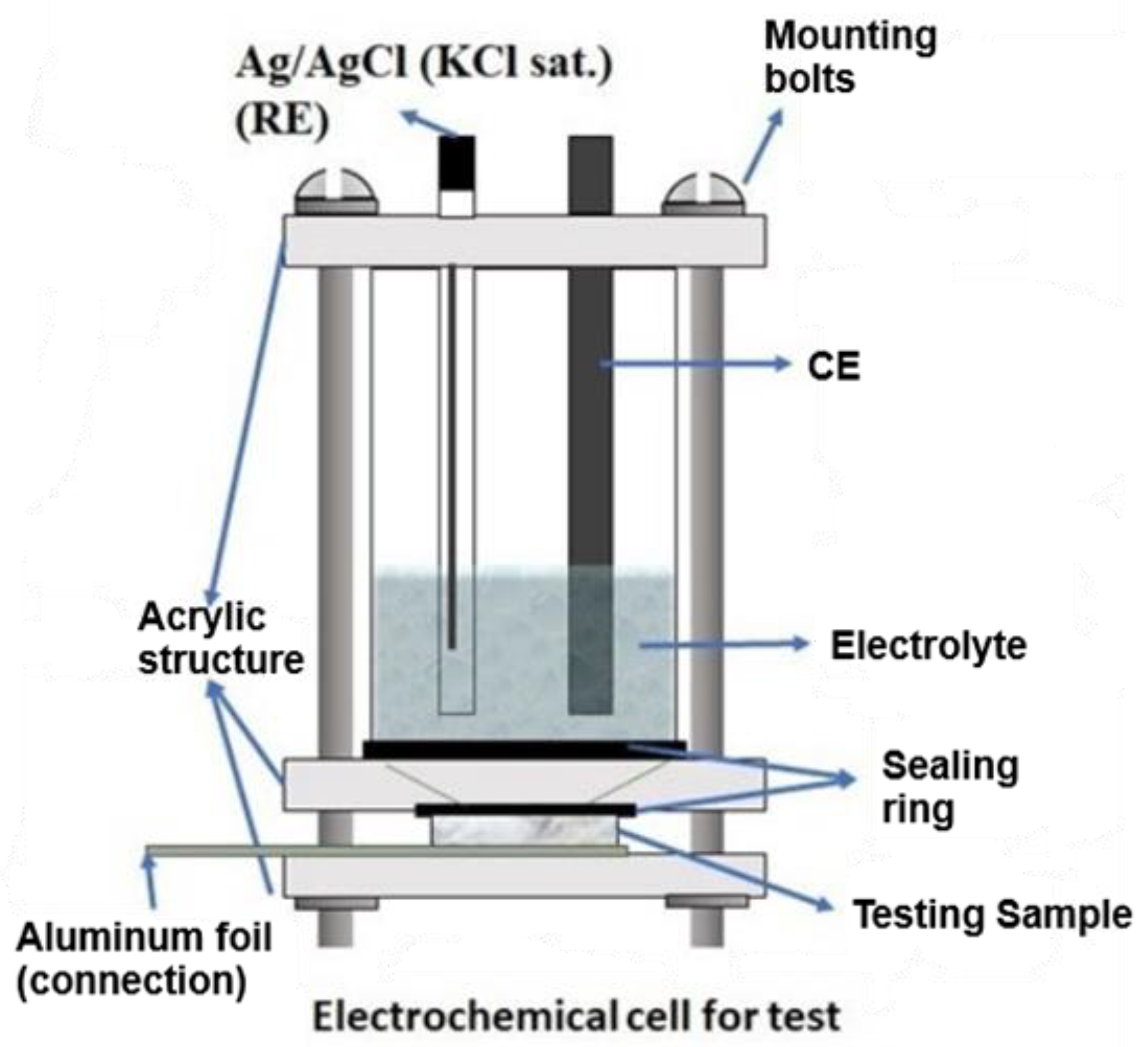
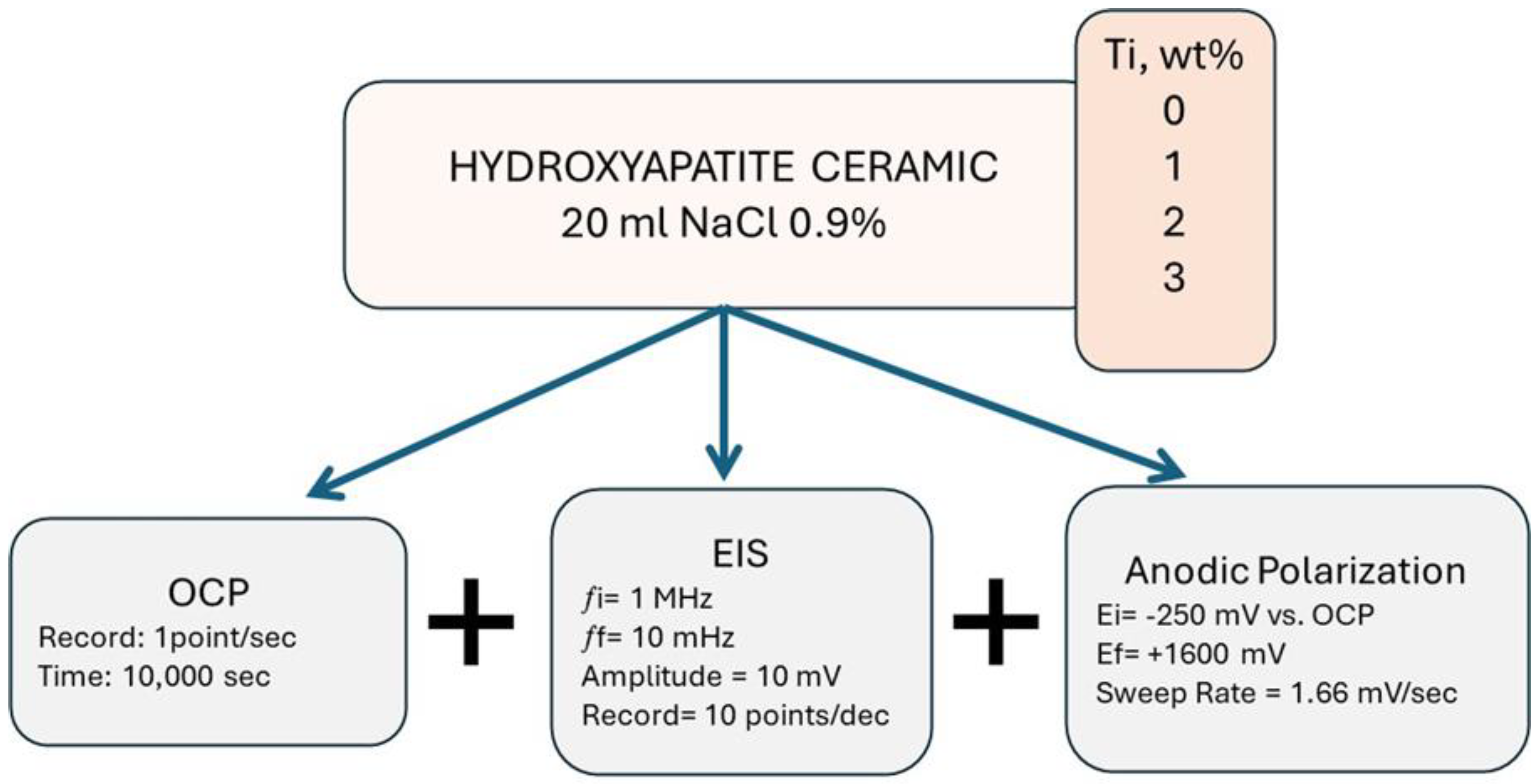

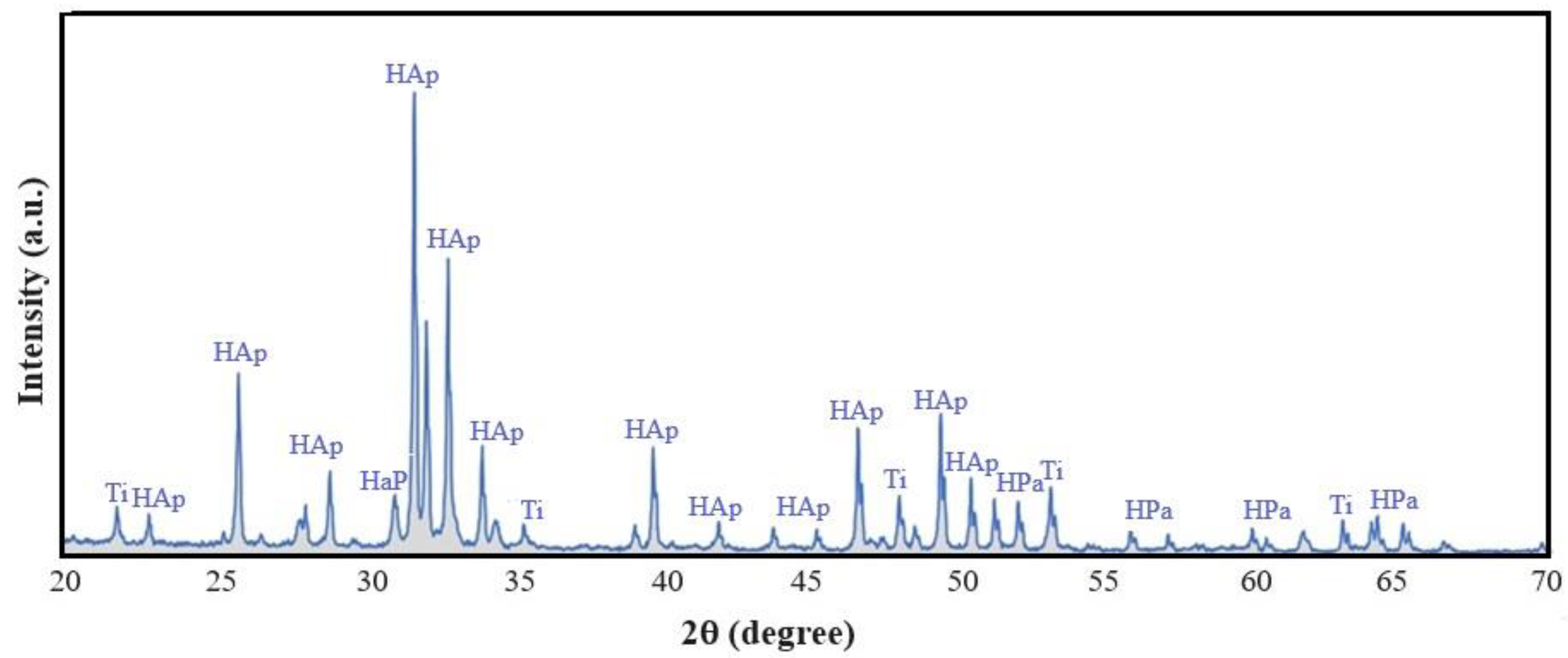
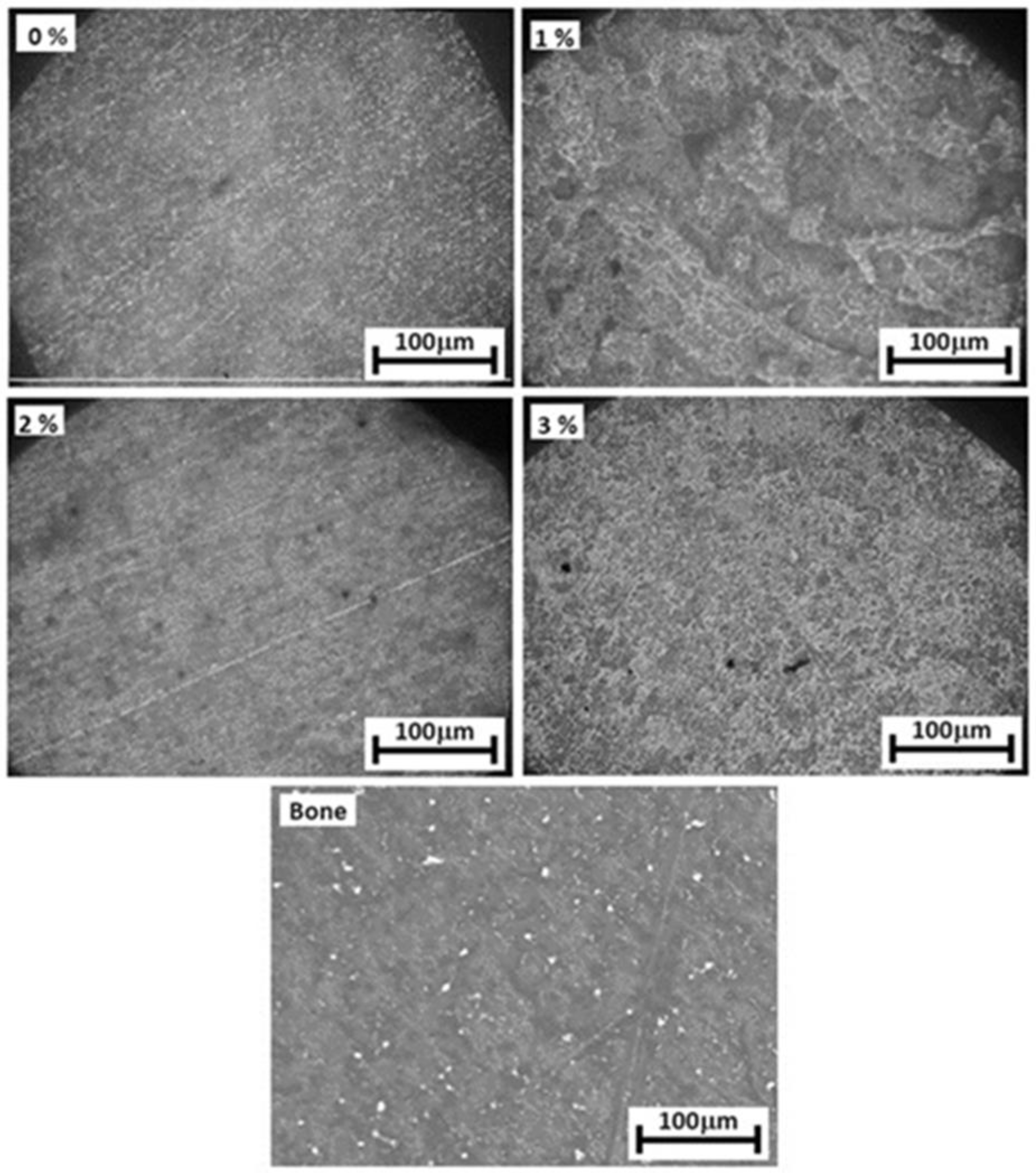
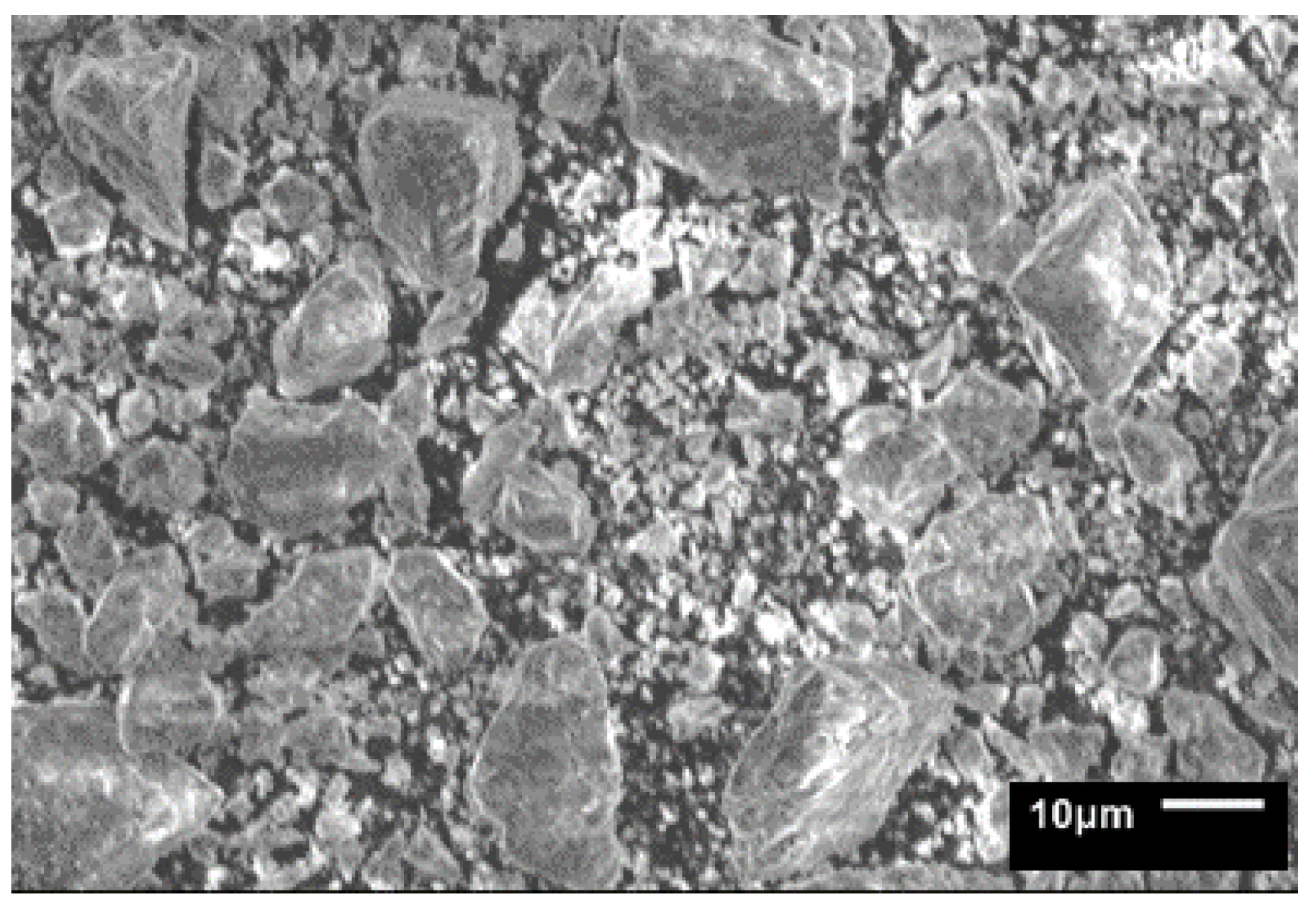


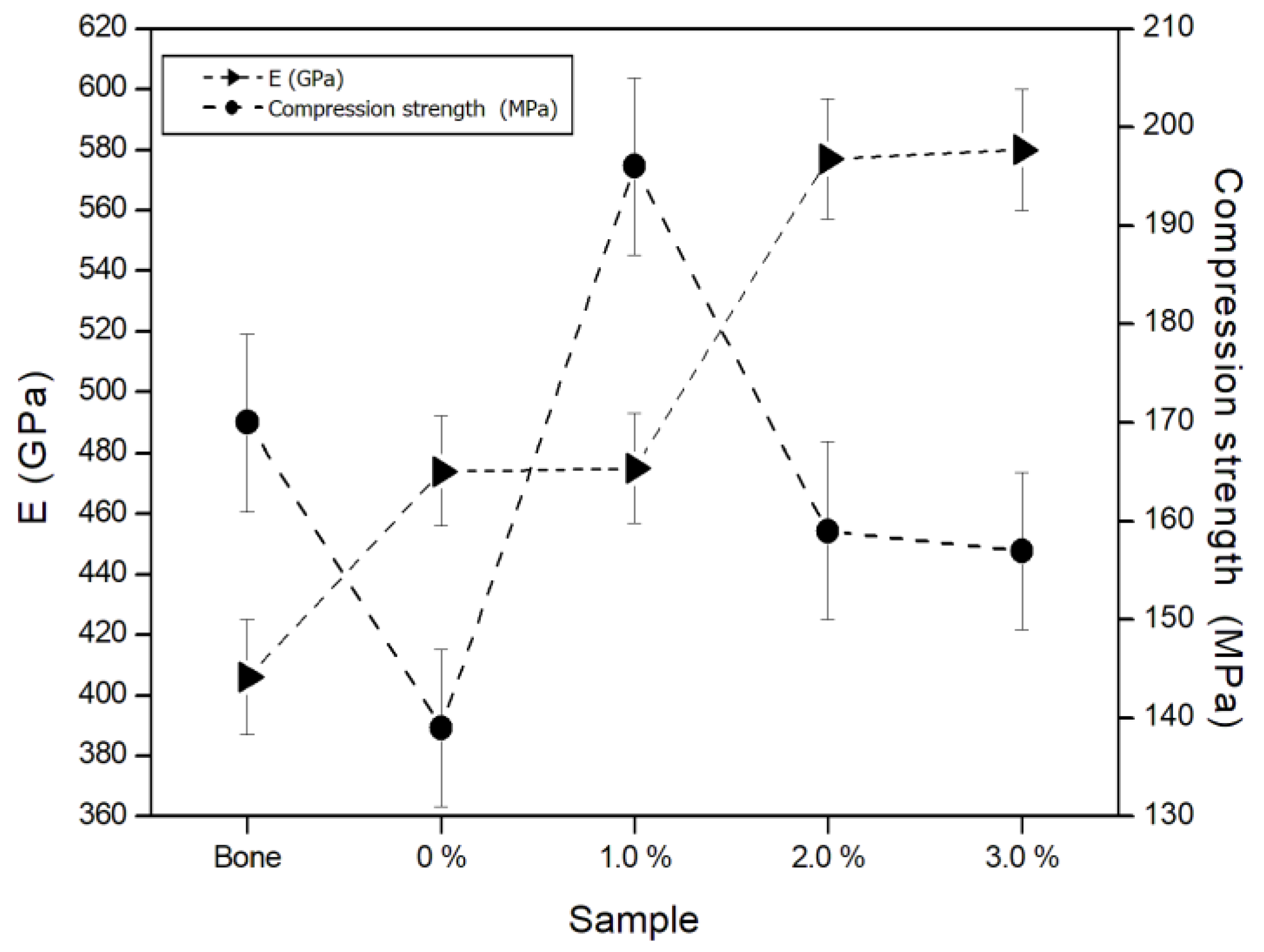

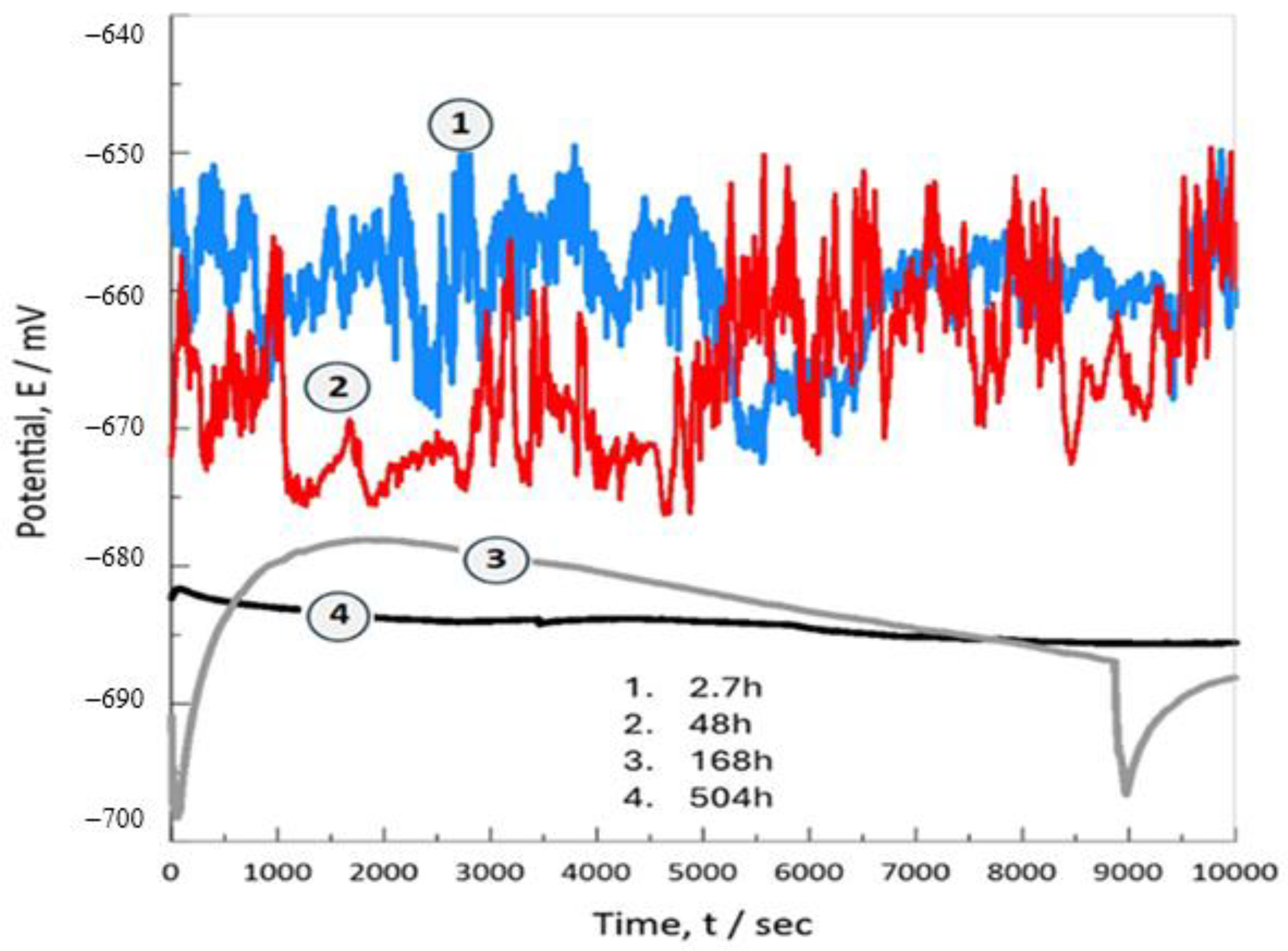
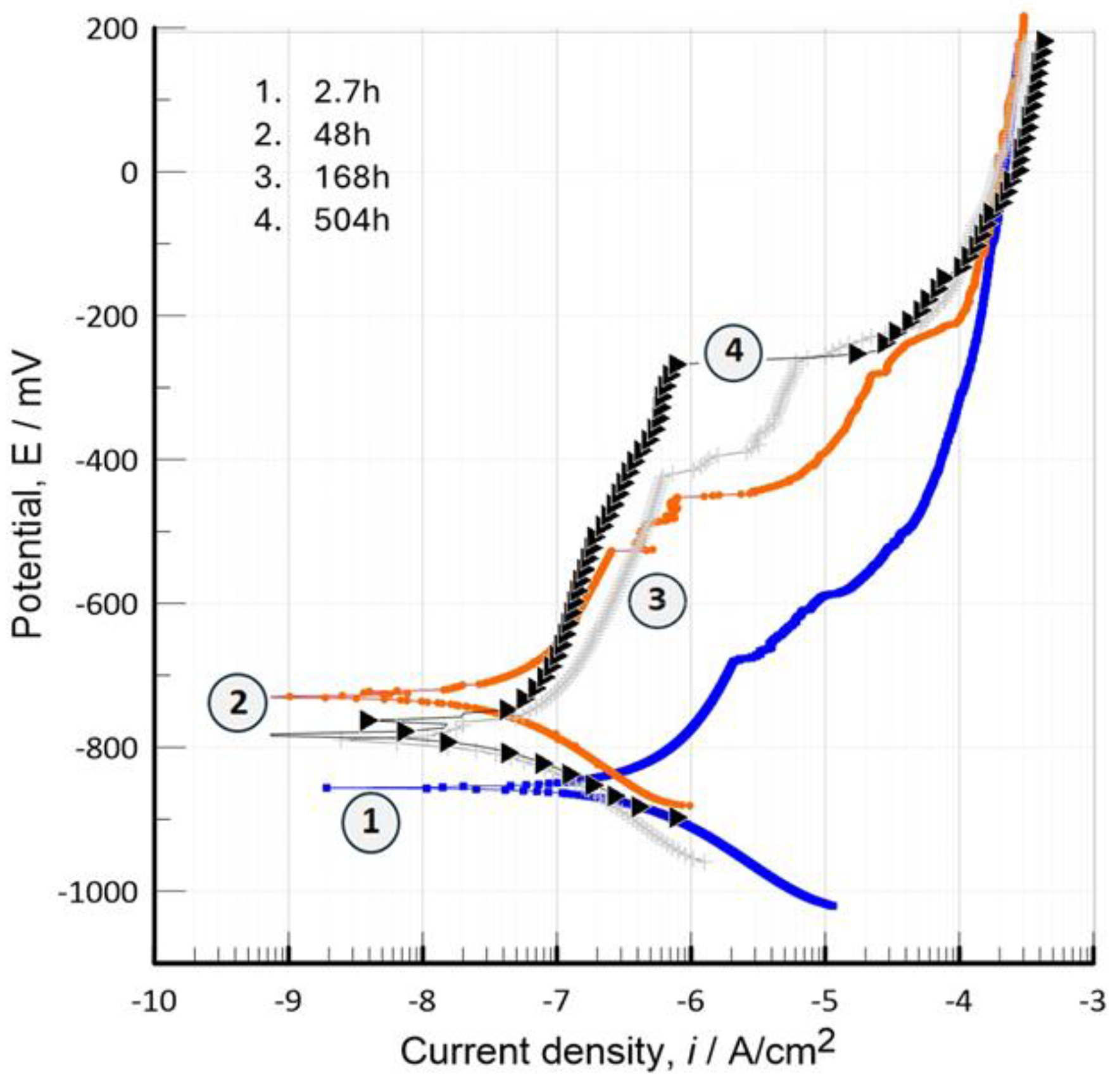



| Inmersión Time, [h] | Capacitance-Cc, [nF/cm2] | Coating Resistance, Rc [Ω-cm2] | Charge Transfer Resistance, Rct [Ω-cm2] | Ecorr/[mV] | Icorr [nA/cm2] |
|---|---|---|---|---|---|
| 5 h | 5.27 | 3447 | 2.745 × 105 | −856.32 | 2.40 |
| 48 h | 5.11 | 3254 | 2.939 × 105 | −730.27 | 0.77 |
| 168 | 3.80 | 2963 | 3.15 × 105 | −789.46 | 3.06 |
| 504 | 0.18 | 810 | 1.526 × 106 | −782.71 | 0.43 |
Disclaimer/Publisher’s Note: The statements, opinions and data contained in all publications are solely those of the individual author(s) and contributor(s) and not of MDPI and/or the editor(s). MDPI and/or the editor(s) disclaim responsibility for any injury to people or property resulting from any ideas, methods, instructions or products referred to in the content. |
© 2024 by the authors. Licensee MDPI, Basel, Switzerland. This article is an open access article distributed under the terms and conditions of the Creative Commons Attribution (CC BY) license (https://creativecommons.org/licenses/by/4.0/).
Share and Cite
Porras-Herrera, D.R.; Herrera-Hernández, H.; Miranda-Hernández, J.G.; Castillo-Robles, J.A.; Armendariz-Mireles, E.N.; Calles-Arriaga, C.A.; Rocha-Rangel, E. Innovative Bioceramic Based on Hydroxyapatite with Titanium Nanoparticles as Reinforcement for Possible Medical Applications. J. Manuf. Mater. Process. 2024, 8, 296. https://doi.org/10.3390/jmmp8060296
Porras-Herrera DR, Herrera-Hernández H, Miranda-Hernández JG, Castillo-Robles JA, Armendariz-Mireles EN, Calles-Arriaga CA, Rocha-Rangel E. Innovative Bioceramic Based on Hydroxyapatite with Titanium Nanoparticles as Reinforcement for Possible Medical Applications. Journal of Manufacturing and Materials Processing. 2024; 8(6):296. https://doi.org/10.3390/jmmp8060296
Chicago/Turabian StylePorras-Herrera, Dafne Rubi, Héctor Herrera-Hernández, José Guadalupe Miranda-Hernández, José Adalberto Castillo-Robles, Eddie Nahúm Armendariz-Mireles, Carlos Adrián Calles-Arriaga, and Enrique Rocha-Rangel. 2024. "Innovative Bioceramic Based on Hydroxyapatite with Titanium Nanoparticles as Reinforcement for Possible Medical Applications" Journal of Manufacturing and Materials Processing 8, no. 6: 296. https://doi.org/10.3390/jmmp8060296
APA StylePorras-Herrera, D. R., Herrera-Hernández, H., Miranda-Hernández, J. G., Castillo-Robles, J. A., Armendariz-Mireles, E. N., Calles-Arriaga, C. A., & Rocha-Rangel, E. (2024). Innovative Bioceramic Based on Hydroxyapatite with Titanium Nanoparticles as Reinforcement for Possible Medical Applications. Journal of Manufacturing and Materials Processing, 8(6), 296. https://doi.org/10.3390/jmmp8060296









